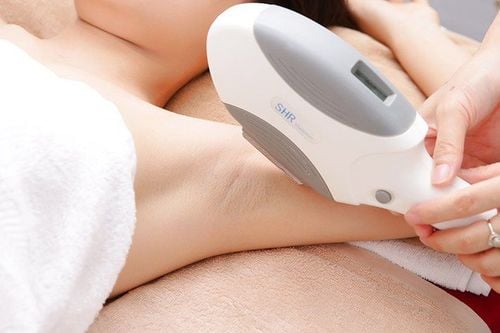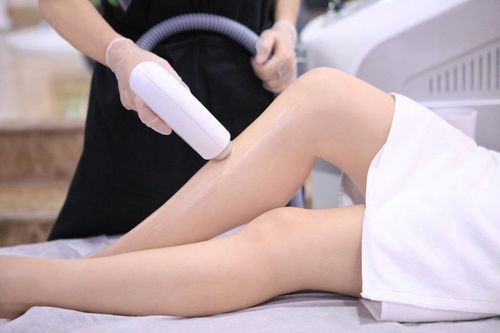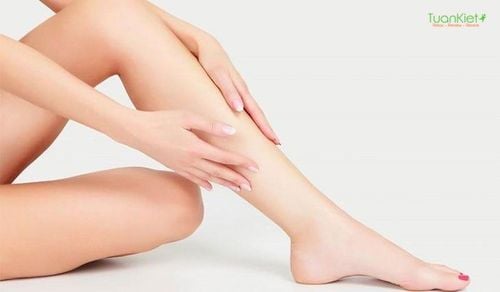This is an automatically translated article.
Everyone has body hair, but depending on the time of year or your personal preference, you may want to remove some of your hair. Contrary to many promotional claims, there are no hair removal treatments that can permanently remove hair. However, there are ways to accomplish hair removal over the course of a few weeks, months, or longer. This article will provide more information about hair removal along with its benefits, side effects, and effectiveness.1. Hair growth rate
According to the American Academy of Dermatology, the average body hair will grow out in about a month. Male hair also tends to grow faster than female hair. The hair on your head can grow about 15 cm in a year.Several factors can affect the rate of hair growth on the whole body including: Nutrition, medications and genetics. The rate of growth may slow down as you age.
Hair growth is a complex process that begins deep within the hair follicle. The hair is nourished by blood as it moves under the surface of the skin. The sebaceous (oil) glands in the skin also play a role in keeping the hair lubricated and healthy.
2. How to remove hair
Shaving is simply removing surface hair and is why hair grows back so quickly. Plucking removes the hair as well as the root of the hair in the pores, which helps to slow down the regrowth process. However, even after plucking the hair from the pore, the hair can still grow back after a few weeks.If you are looking for more permanent hair removal solutions, including permanent hair removal, it may be time to consider other hair removal methods. The following methods are ranked according to their ability to remove hair in the longest time and can be applied to pubic hair removal.
2.1. Electrolysis Electrolysis involves the use of shortwave radio frequencies that are delivered by means of fine needles placed directly into the hair follicles on your body. The purpose of destroying the hair follicle is so that it does not stimulate new hair growth. This procedure requires that it be performed by a dermatologist or a certified electrologist.
Unlike other hair removal options, electrolysis is considered a permanent solution and is approved by the US Food and Drug Administration (FDA). However, for this method to have the best results, you will need to have multiple follow-up visits. Most people need a follow-up visit every week or two.
Electrolysis can be performed anywhere on the body, and is effective for most skin types. The most common side effects of electrolysis include: Pain and redness due to skin irritation (common in sensitive skin). Rare but serious side effects that can affect your health include: Needle scarring and infection, and keloids (an overgrowth of scar tissue).
2.2. Laser Hair Removal Laser hair removal is an option of permanent hair removal. Similar to electrolysis, this treatment targets the hair follicle. Laser hair removal works by damaging the hair follicle with a high-heat laser to prevent new hair from growing.
Laser hair removal can be done anywhere on the body, except for the eye area. Laser treatments tend to be most effective in people with light skin tones and dark hair.
Similar to electrolysis, laser hair removal requires several sessions for best results. Depending on the area of hair removal, you may need an interval of four to six treatments, each of which can be spaced four to eight weeks apart.
In most cases of laser hair removal, hair removal takes several months and in some cases, years. When the hair grows back, the hair is usually finer and lighter in color. However, laser hair removal does not guarantee permanent hair removal.
The most common side effects of laser hair removal include: Skin irritation and redness but usually disappear after a few hours. Laser treatments can also cause temporary pigmentation changes, especially with darker skin tones. More serious laser side effects include: Blistering and scarring, but this is rare.

Laser là một trong những phương pháp tẩy lông vĩnh viễn thường được sử dụng
A special compound eflornithine (Vaniqa), to be applied twice a day for a month. Eflornithine (Vaniqa) works by inhibiting the production of enzymes that stimulate hair growth.
Research on this treatment says that results can last up to eight weeks, after which you can start over using the cream. Eflornithine only works on facial hair and is more suitable for use by women. Using the topical cream can have a number of side effects that can include burning, rashes, and breakouts from disrupting hair follicles.
2.4. Professional Weezing and Waxing An option for smaller areas of your body is professional waxing, performed by a certified esthetician. When hair is removed in this way, the hair is pulled directly out of the pore. Depending on the rate at which body hair grows, the results of hair removal can last from two to eight weeks.
The Weezing option is less expensive than laser or electrolysis but you may need to repeat the treatment more often.
Although epilation can be performed on any area of the body, it is not recommended to wax around the genitals, nipples, ears or eyelashes. You should also avoid applying wax to varicose veins, areas with moles or warts, or on chapped or sunburned skin.
The most common side effects of both semi-professional and professional hair removal include: Mild rash and irritation but are usually temporary.
2.5. Chemical depilation Chemical hair removal treatments include over-the-counter gels or creams that you apply to your skin. It works by weakening a protein in your hair - keratin - which causes hair to fall out and become prone to rolling.
The hair removal process does not target the hair follicle, so the results of this method may only last for about two weeks. However, using chemicals seems to be an inexpensive option that you can do at home.
You need to be careful to use the right hair removal cream for the area you want to remove hair. Some creams are formulated for facial hair removal and others for the body or pubic area.
You should test a small area of skin before using chemical hair removal on a larger area of skin. Side effects of chemical treatments can include: Chemical burns, rash, and blistering.

Một số loại kem/gel có tác dụng làm rụng lông
Sugar waxes and scrubs. Honey instead of wax. Drink peppermint tea twice a day to limit the growth of facial hair. If your hair continues to grow back very quickly despite trying different hair removal treatments, make an appointment with your doctor. This condition can be a symptom of an underlying condition such as polycystic ovary syndrome (PCOS) or hyperthyroidism.
Hair removal methods can also apply ingrown hair removal. In some cases, waxing can lead to infection. Contact your doctor if you have widespread ingrown hairs, if they have become infected or turned into cysts during waxing.
It's completely normal to have body hair and it's not mandatory to get rid of it. You should talk to your doctor or dermatologist about the best options for you.
Please follow the website: Vinmec.com regularly to update other useful information.
Please dial HOTLINE for more information or register for an appointment HERE. Download MyVinmec app to make appointments faster and to manage your bookings easily.
Reference article: healthline.com












